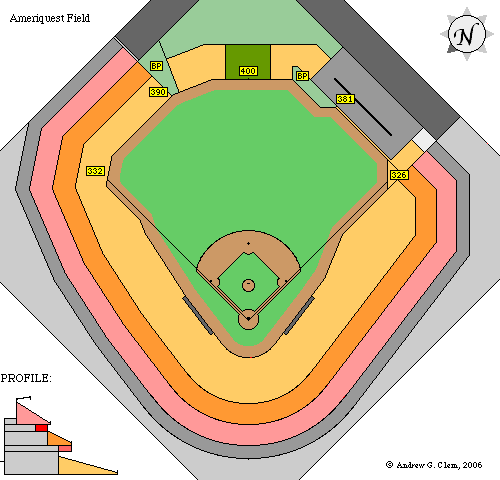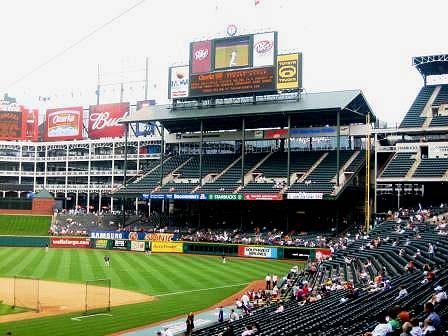ALL STAR GAME: 1995
This ballpark is controversial for several reasons (see below), but one thing is certain: the Rangers desperately needed a new stadium. The "Ballpark in Arlington" was the second of the neoclassical stadiums, preceding Jacobs Field by just a few days. It has so many features that it is hard to know where to begin or what to make of it all. It seems more like an amusement park than a baseball stadium, which is perhaps not surprising, since it's located within a mile of Six Flags Over Texas. It was built just a few blocks south of the Rangers' previous home, in the suburbs of Dallas-Fort Worth, Texas. The wide open spaces of Arlington stand in sharp contrast to the cramped urban surroundings of Oriole Park at Camden Yards. The overall structure (including the shops, museums, etc.) fits into a perfect square, with a small diagonal facet at each corner, which technically makes it an octagon. There are two pyramid-topped brick towers at each of the main entrances at those corners, rather like the turrets of a fortress. In order to create the illusion of being "downtown," a four-story L-shaped office building was built in center field. It features ornate wrought iron balconies that remind one of New Orleans, but there are huge tacky billboards on top of it.
 The problem with this "ballpark" is that it takes every one of the basic design virtues of the neoclassical stadiums and amplifies them to absurd proportions. For example, there are seven corners in the outfield wall, more than you will find in some pinball machines. Furthermore, every one of those seven corners has a distance marker, though only two are shown in the above diagram. From left field to right field, the others are: 354, 404, 407, 377, and 349 feet. More to the point, since the neighborhood streets did not really constrain the stadium's design, all of the quirky angles and turns in the outfield wall are purely arbitrary and contrived. It's all a bit phony. Also, there seems to be more brick around the massive exterior walls than one would find in all of Georgetown and Old Town Alexandria put together! Conversely, foul territory is tiny, because of the closeness of the seats behind home plate and the long flange/alley, which is most pronounced along the right field line. One design problem is that there is virtually no overhang below the upper deck, which is therefore situated quite far from the field, and quite high above it, thanks to the two skybox levels, a fundamental flaw shared with U.S. Cellular Field. There is no overhang below the second deck in left field, because a private club of some sort occupies that space. Minor gripe: the very slight bends in the grandstand on the third base side merely add "clutter" to the overall design, without much improvement in the sight lines. Such bends should either be more distinct or else eliminated.
The problem with this "ballpark" is that it takes every one of the basic design virtues of the neoclassical stadiums and amplifies them to absurd proportions. For example, there are seven corners in the outfield wall, more than you will find in some pinball machines. Furthermore, every one of those seven corners has a distance marker, though only two are shown in the above diagram. From left field to right field, the others are: 354, 404, 407, 377, and 349 feet. More to the point, since the neighborhood streets did not really constrain the stadium's design, all of the quirky angles and turns in the outfield wall are purely arbitrary and contrived. It's all a bit phony. Also, there seems to be more brick around the massive exterior walls than one would find in all of Georgetown and Old Town Alexandria put together! Conversely, foul territory is tiny, because of the closeness of the seats behind home plate and the long flange/alley, which is most pronounced along the right field line. One design problem is that there is virtually no overhang below the upper deck, which is therefore situated quite far from the field, and quite high above it, thanks to the two skybox levels, a fundamental flaw shared with U.S. Cellular Field. There is no overhang below the second deck in left field, because a private club of some sort occupies that space. Minor gripe: the very slight bends in the grandstand on the third base side merely add "clutter" to the overall design, without much improvement in the sight lines. Such bends should either be more distinct or else eliminated.
On the plus side, the double-deck bleacher section in right field, complete with an old-fashioned full roof and steel support beams, is a nice (if too-obvious) tribute to Tiger Stadium. That roof is elevated an extra 20 feet or so to give the patrons at the Sports Grill a view of the game. Thus, the scoreboard/Jumbotron on top of that roof is situated high enough that it doesn't distract too much from the field itself. Another definite plus is the grass bank beyond the center field fence and the small courtyard in front of the office building. It's also nice that the stadium name (which is admittedly corny) was not simply sold to the highest bidder, as was the case in Houston, Seattle, and Detroit. (That might have been a good name for the proposed stadium in Northern Virginia.) In a gesture to historic continuity, the Rangers brought the foul poles and bleacher benches over from their original home field. The 1,500-capacity bleachers here pale in comparison to the old Arlington Stadium, but at least it's something for budget-minded fans.
Being located on the high plains of Texas, this field is subject to occasional high winds, which the office building enclosing the outfield does little to prevent. During the first month of play here, in April 1994, pitcher Rick Kelly was blown off the mound by a sudden gust, and the game was delayed for 45 minutes until the wind calmed down a bit. Just like the 1961 All Star Game in Candlestick Park!
A few minor modifications were made in 2000. An inner fence was installed in left field, reducing the distance on that side by two feet. Also, the rows of seats in the small triangular section in the right field corner were replaced by stools and cafe tables. This reduced the overall capacity by 51 seats.
CINEMA: The climactic scenes from the motion picture The Rookie (2002), starring Dennis Quaid, were filmed in this ballpark. Particularly noteworthy are the huge arched hallways along the perimeter of the stadium structure.
The Rangers had little to brag about from their first two decades (or from their previous decade as the Senators, for that matter), but they quickly became serious contenders after moving into their new home. Indeed, they were leading the AL West when The Strike of 1994 ruined everything, and they won the divisional titles in both 1996 and 1998, when Tom Hicks bought the team and soon went on a spending spree. In December 2000 Alex Rodriguez joined the Rangers after signing the biggest contract in baseball history, worth $252 million. The team's roster featured such hitting and fielding stars as Ivan Rodriguez, Juan Gonzalez, Rafael Palmeiro, Andres Galarraga, but the Rangers could not assemble a decent pitching staff and thus finished in last place once again, and have stayed there -- until 2004, that is.
In May 2004 the Rangers and Ameriquest Mortgage Company announced a 30-year, $75 million agreement under which the Ballpark in Arlington was renamed "Ameriquest Field in Arlington." This happened to coincide with the Rangers' resurgence, vying with Anaheim for top spot in the AL West.
SOURCES: USA Today / Fodor's (1996), Rosen (2001)


 Site map
Site map Photo!
Photo!

